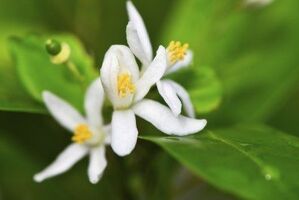Summary[]
Kumquats (or cumquats in Australian English, Citrus japonica) are a group of small fruit-bearing trees in the flowering plant family Rutaceae. They were previously classified as forming the now historical genus Fortunella, or placed within Citrus sensu lato.
Origin[]
Name[]
The English name "kumquat" derives from the Cantonese gām-gwāt (chinese characters as 金橘), literally meaning "golden orange" or "golden tangerine".
Though loquats are not botanically related to kumquats, the terms derive from the same Chinese word for "orange". Lougwat, literally "black orange", originally referred to unripe kumquats, which are dark green, but due to a misunderstanding by poet Su Shi, Cantonese regions widely took up the new name for the non-citrus fruit known in Mandarin Chinese as a pipa.
Origin[]
The kumquat plant is native to south Asia and the Asia-Pacific region. The earliest historical reference to kumquats appears in literature of China in the 12th century. They have long been cultivated in India, Japan, Taiwan, the Philippines, and southeast Asia. They were introduced to Europe in 1846 by Robert Fortune, collector for the London Horticultural Society, and shortly thereafter into North America.
Appearance[]
The edible fruit closely resembles the orange (Citrus sinensis), but it is much smaller, being approximately the size and shape of a large olive. Kumquat is a fairly cold-hardy citrus.
Flower[]
Appearance[]
The colour of a kumquat flower is white.
Propagation and Pollination[]
Kumquats do not grow well from seeds and so are vegetatively propagated, using rootstock of another citrus fruit, air layering or cuttings (using a rooting gel/powder). They are self-pollinating as are most citrus.

A kumquat.

A fully developed kumquat flower.
